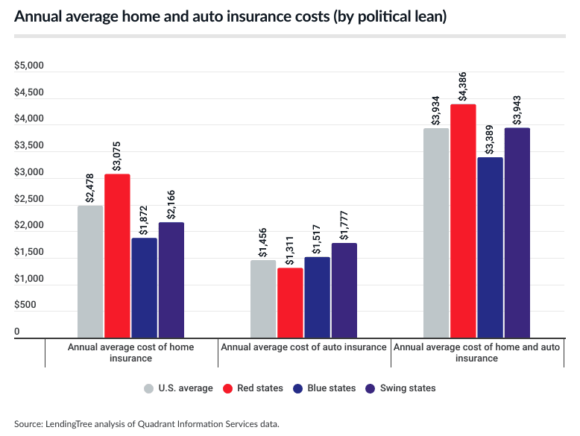There’s not only a broadening divide between the ideologies of Democrats and Republicans, but there seems to be quite a difference in how much they spend on insurance premiums.
Red, blue and swing states differ when it comes to annual average premiums paid for auto and homeowners insurance, according to a report from LendingTree.
LendingTree researchers analyzed home insurance data from Quadrant Information Services. Auto insurance premiums were analyzed using data reflecting the average of premiums for minimum- and full-coverage policies for a 35-year-old male driver with a clean driving record.
Red states pay the most on average for homeowners insurance at $3,075 annually. That’s $904 more than swing states with an average of $2,166, while blue states spend an average of $1,872, according to the report.
The report shows nine of the 10 states with the highest annual average homeowners insurance rates leaning red. The states that pay the most on average for homeowners insurance are solid red states: Oklahoma ($5,478), Nebraska ($5,363), Kansas ($4,825) and Texas ($4,467).
Swing states pay the highest annual average auto insurance premiums with an average of $1,777 annually, more than the $1,517 in blue states and $1,311 in red states. The majority of the states with the highest annual average auto insurance premiums lean blue, according to the report.
The states with the highest auto insurance premiums are Michigan ($3,814,a swing state), Florida ($2,488, red), Nevada ($2,371, swing), Louisiana ($2,363, red) and Rhode Island ($2,270, blue).
Between 2023 and 2024, six of the 10 states with the highest cumulative homeowners insurance premiums increases leaned red, while six of the 10 with the highest cumulative auto insurance rate increases leaned blue.
Leading the way for homeowners insurance were the red state Utah (39.9%), the red state Nebraska (38.2%) and the swing state Arizona (37.5%). For auto insurance, swing state Nevada (40.4%), blue state Washington (38.8%) and blue state New York (31.4%) were on top of the list.
LendingTree defined states as red (Republican-leaning), blue (Democratic-leaning) or purple swing states using the 2024 Cook Political Report (CPR) Electoral College Ratings.
Was this article valuable?
Here are more articles you may enjoy.


 Tricolor Trustee Plans to Sue Founder for Auto Dealer’s Collapse
Tricolor Trustee Plans to Sue Founder for Auto Dealer’s Collapse  Atmospheric River to Flood Pacific Northwest Through Week
Atmospheric River to Flood Pacific Northwest Through Week  Losses Top $20 Billion in Asia Floods as Climate Risks Grow
Losses Top $20 Billion in Asia Floods as Climate Risks Grow  Zillow Deleting Climate Risk Scores Reveals Limits of Flood, Fire Data
Zillow Deleting Climate Risk Scores Reveals Limits of Flood, Fire Data 